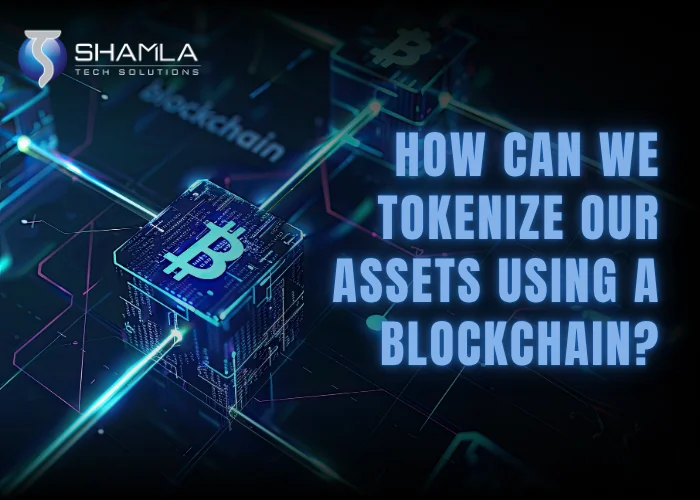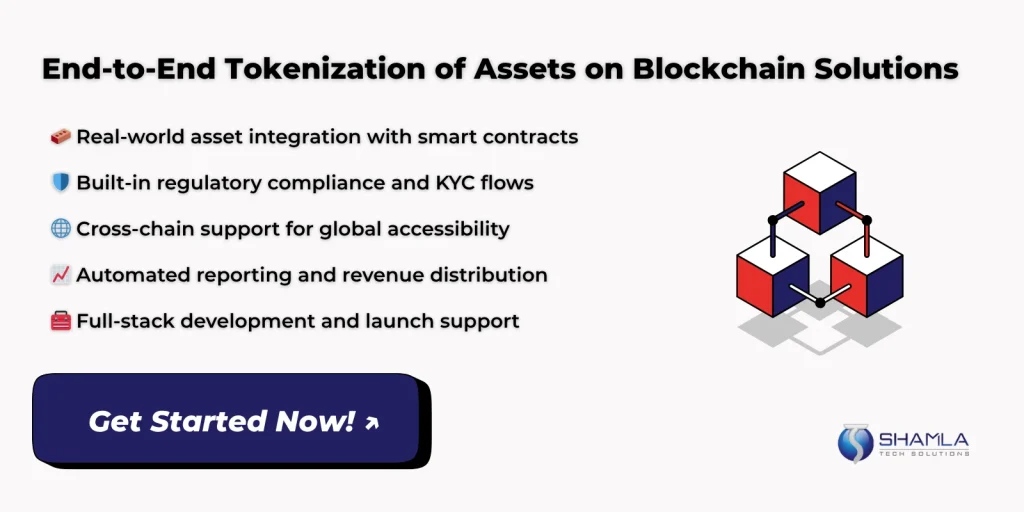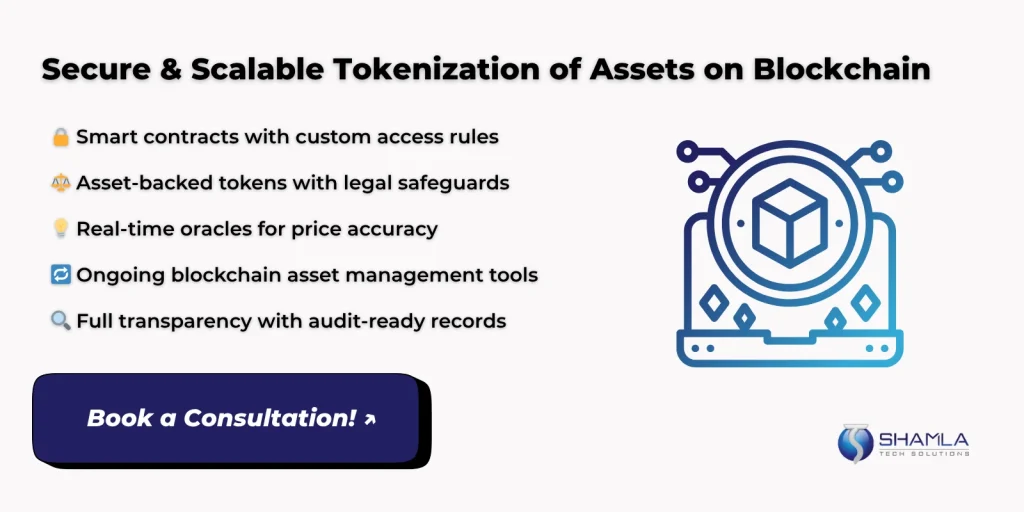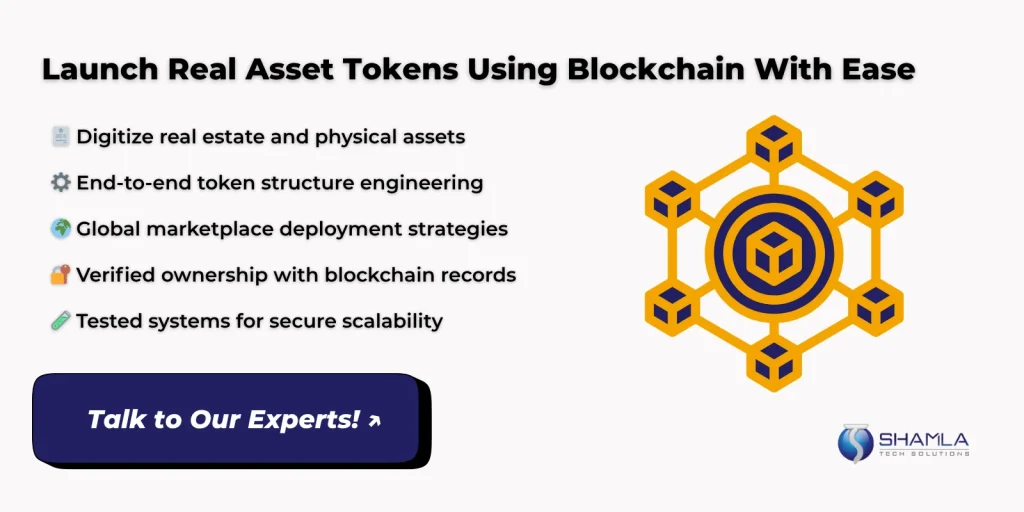Tokenization of assets on blockchain transforms ownership by converting property rights into digital tokens that run on ledgers. This process divides holdings into tradeable units, boosts liquidity, and cuts transfer costs. Using automated contracts, each token maps to specific asset details and rules, ensuring transparent tracking and automatic checks.
Investors gain access to fractional slices of real estate, art, commodities under clear governance. Platforms use strong data protection to guard data, standard rules ensure they work together across systems. As markets adopt this model, trading fractional ownership becomes seamless, opening new funding channels, routes, broadening secure access to digital assets.
7 Effective Steps for Tokenization of Assets on Blockchain
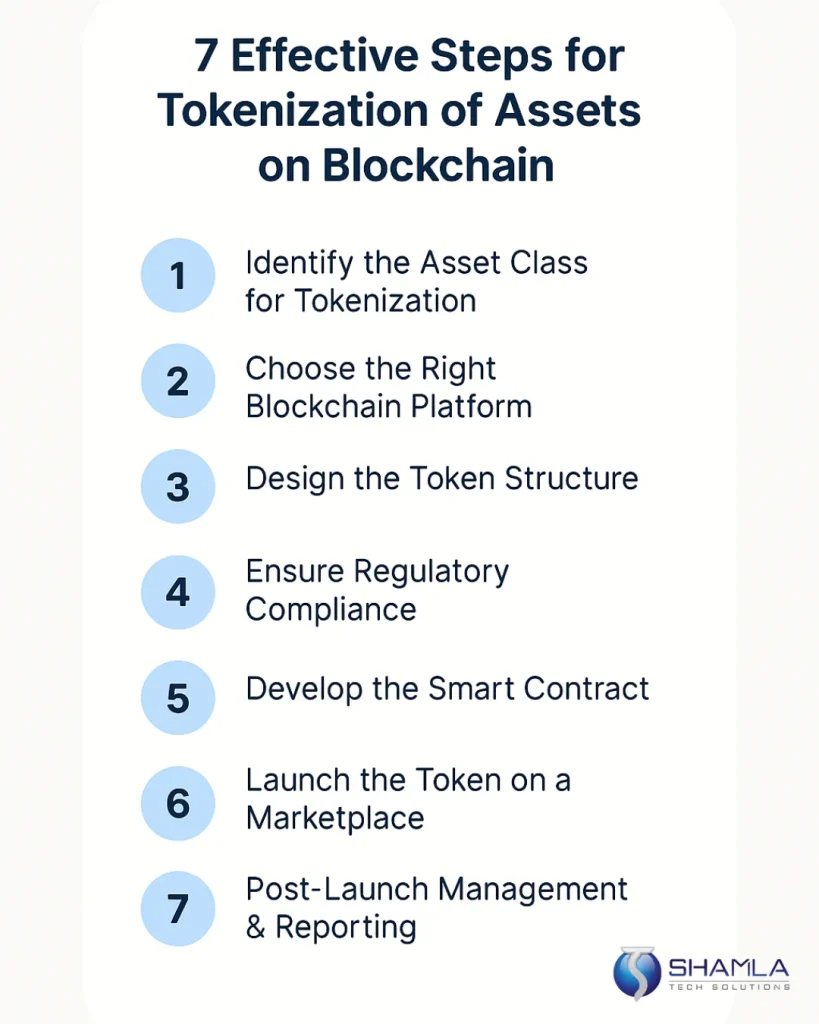
Step 1: Identify the Asset Class for Tokenization
Outline property features and ownership rights. Select buildings or land that fit fractional code. Use tokenized real estate models to map shares to value. The tokenization of assets on blockchain ensures each unit links to legal documents. Confirm land registry data matches on-chain records. Assess market trends and rental yield forecasts.
Set rules for share transfers, voting rights, dividends. Use open token standards for fairness. The tokenization of assets on blockchain standardizes token behavior. Integrate investor identity checks in smart contracts. Specify transfer limits and lockup periods. Clearly document governance framework publicly and align with local regulations to avoid disputes. Define emergency pause functions for contract faults and dispute resolution mechanisms.
Classify your holdings into tangible and intangible forms. Evaluate which digital assets, like token-based coins, NFT shares, or tokenized commodities, fit project goals. Check market depth, trading volume, and investor interest for each category. Confirm existing asset valuation methods feed seamlessly into smart contracts. That builds realistic pricing and supports quick on-chain trading. Define clear metadata standards for asset tracking.
Gather official records and certificates for the asset. Verify ownership history and lien status through trusted registries. Convert those records into digital proofs stored on-chain. Use oracles or secure APIs to feed external data into smart contracts. That keeps token balances aligned with real holdings. Set up regular audits to confirm on-chain state matches off-chain records. Implement immutable timestamp logging.
Calculate baseline value using reliable appraisal models. Translate that value into token price and supply. Determine decimal precision for fractional units. Build smart contract logic to update prices with market data. Include cap limits to avoid extreme volatility. Define revenue distribution rules for income generating assets. Enable real-time price feeds for accurate valuation. Regularly review valuation assumptions with external advisors.
Step 2: Choose the Right Blockchain Platform
Compare public and private chains by cost, speed, and security. Public chains offer open networks but higher fees. Private chains deliver lower fees, quicker validations, and permissioned access. Choose a platform based on transaction volume and governance needs. Ensure the network supports your token standards. This choice impacts tokenization of assets on blockchain performance and user experience. Consider cross-chain bridges for reach.
Assess layer-1 versus layer-2 solutions for scaling. Layer-2 reduces network load and transaction costs. Layer-1 delivers native finality and broad support. Match solution to project size and speed demands. Verify integration with existing wallets and exchanges. Test interoperability to avoid fragmentation. Focus on how tokenization of assets on blockchain will benefit from this. Monitor gas price trends regularly before deployment.
Review platform consensus models like Proof of Stake, Proof of Authority, and Practical Byzantine Fault Tolerance. Pick low-energy models to cut user fees. Confirm block finality time meets trading demands. Test smart contract deployment speed and network stability. Ensure platform compatibility with your development tools. Embrace blockchain technology that aligns with token lifecycle needs. Review API support and developer plugins.
Check built-in tools for reporting, monitoring, and treasury management. Ensure ledger explorers provide transparency for stakeholders. Integrate custom dashboards to track token supply, holder data, and transaction logs. Leverage automated alerts for compliance breaches. Plan for upgrades that support blockchain asset management across partner networks, avoiding vendor lock-in. Plan for version updates and backward compatibility. Conduct stakeholder training sessions annually.
Prioritize security features such as multisig wallets, on-chain governance modules, and formal audits. Validate code libraries and dependency versions to prevent exploits. Collaborate with certified security firms for regular penetration tests. Implement role-based access controls and time locks. Secure private keys in hardware modules and backup procedures in cold storage. Add encrypted backups off-chain and regular disaster rehearse schedules monthly.
Step 3: Design the Token Structure
Define Token Controls: Set clear token permissions and supply limits to match underlying value. Use open standards like ERC-20 or ERC-721 to enforce automated rules. Plan minting, burning, and transfer functions precisely. Align token metadata with legal frameworks and store proofs on-chain. Ensure tokenization of assets on blockchain links each digital unit to fixed asset records and ownership rights. Include secure validation checks.
Build Economic Framework: Design token economics to reflect asset cash flows and scarcity. Define funding rounds, pricing tiers, and allocation caps in contract code. Use on-chain oracles to update market rates and adjust token supply. Integrate vesting schedules for early investors. Ensure transparency through immutable ledgers. Support interoperability and cross-chain swaps. Precise framework guides tokenization of assets on blockchain across diverse investor classes.
Link Real Assets: Choose collateral types, such as property, bonds, or commodities. Set minimum collateral ratios to back tokens. Embed redemption rights in code to allow on-demand asset swaps. Audit collateral reserves regularly and publish proofs. Offer records, ensuring token holders can verify underlying holdings. Asset backed tokens build trust by linking digital units directly to real stores of value and legal claims.
Encode Security Features: Define security token categories and rights for equity, debt, or revenue shares. Encode dividend schedules, voting rules, and liquidation preferences into contract modules. Use audit trails for every issuance and settlement. Verify investor accreditation off-chain and integrate KYC results on-chain. Tokenized securities enable seamless trading under regulated frameworks. Ensure compliance events trigger automated reporting to authorities and secure audit logs.
Ensure Physical Sync: Plan asset custody and insurance to safeguard physical holdings. Use multi-layer storage strategies and insured vault services. Sync on-chain token balances with off-chain asset ledgers via oracles. Schedule routine inspections and audits to confirm existence and condition. Connect token economics to maintenance funds and reserve accounts. This real asset tokenization ensures each digital token maps to a tangible real asset.
Step 4: Ensure Regulatory Compliance
Map local rules before issuing tokens. Review asset laws and market rules. Align permits with your token models. Use legal advice to draft trust deeds and offer documents. Verify how tokenization of assets on blockchain fits property rules. Set frameworks for transfers and capital. Clear licensing prevents legal gaps. Plan for license renewals ahead of launches smoothly.
Establish investor identity checks and screening. Integrate KYC and AML into token flows. Partner with compliance platforms for real-time reviews. Automate sanctions list scans and risk scoring. Build audit logs for every user event. Prioritize data privacy and encryption. Meet ongoing regulatory compliance demands by scheduling policy audits and staff training. Regular updates keep the process robust.
Analyze cross-border rules to prevent conflicts. Check how escrow and custody operate under each law. Determine if tokens classify as securities or commodities. Adjust token rights to match local rules. Verify that tokenization of assets on blockchain meets tax and reporting standards. Use legal oracles for rule updates. Plan dispute resolution clauses. Cross-jurisdiction clarity avoids fines.
Set transparent reporting for token sales and holdings. Configure smart contract events to log distributions, dividends, and transfers. Share regular statements with authorities. Use encrypted portals for audit requests. Implement automatic filings when thresholds trigger. Engage certified auditors to verify code and fund flows. Address gaps quickly. Clear records support strict regulatory compliance and foster trust with stakeholders.
Engage experts in tokenizing real world assets for legal and technical guidance. Use case studies to refine processes. Develop clear white papers that explain asset linkage, rights, and risks. Coordinate with banks to onboard funds. Build templates for custody agreements and insurance certificates. Schedule stakeholder reviews. Test full issuance cycle in sandbox. Expert collaboration streamlines compliant token launches.
Step 5: Develop the Smart Contract
Use modules to control token creation, destruction, and supply limits. Write code that enforces asset rights. Adopt a common standard like ERC-20 to ensure tokens are divisible and easily traded. Attach specific property-related data to each token to establish a clear link to real-world assets. Test the code on local testnets. This code is key to tokenization of assets on blockchain. Then run rigorous security audits.
Fetch real-time price data and legal terms using secure oracles. Code functions that adjust token supply based on external triggers and integrate time locks for controlled distribution. This setup ensures tokens mirror actual asset values. Validate each oracle input to prevent fraud. Leverage blockchain technology to store oracle results. These measures reinforce tokenization of assets on blockchain.
Design upgradeable contracts to support future rule changes without code rewrites. Use proxy patterns to separate logic and storage. Record tokenized real estate holdings, distributions, and voting events on-chain. Trigger events to keep off-chain dashboards updated and support routine audit processes. This approach boosts blockchain asset management by automating records and offering transparent, tamper-proof logs. Secure update paths with multi-signature controls.
Write unit tests for each contract function and use fuzz testing to find edge-case bugs. Deploy code to local testnets and public testnets to verify gas usage and performance. Automate continuous integration pipelines for builds and tests. Perform third-party audits and formal verification on critical modules. Document test results and remediation steps. This thorough vetting prevents runtime failures and exploits.
Deploy contracts via secure pipelines and use on-chain governance for upgrade approval. Monitor key metrics like transaction success, gas spikes, and error rates through automated alerts. Set rollback plans for faulty releases. Update logic modules via proxy patterns. Ensure the team has clear deployment runbooks and keys in hardware modules. Maintain continuous monitoring dashboards and regular health checks.
Step 6: Launch the Token on a Marketplace
Initiate listing by selecting an exchange that supports your token standard. Submit KYC documents and legal memos. Verify wallet whitelisting and onboarding flows. Coordinate with exchange teams for liquidity provisioning and market making. Use promotional windows to attract initial traders. Monitor listing status and announcement channels. This launch process shapes tokenization of assets on blockchain visibility and success.
Set price discovery through an auction or direct sale model. Define reserve price and bidding increments in contract. Use on-chain auctions to ensure fairness. Capture market-driven values before open trading. Publish auction results on dashboards. Enable partial fills and settlement via automated scripts. This method underlines tokenization of assets on blockchain by matching demand and supply transparently.
Work with decentralized exchanges or security token platforms that permit asset backed tokens. Ensure platform KYC and AML align with your token rules. Integrate smart contract hooks for custody verification. Plan initial and continuous liquidity pools to support trading. Use standard interfaces for wallets and dashboards. This setup guarantees token holders can exchange units reliably across multiple networks.
Coordinate listings on regulated security token venues supporting tokenized securities. Provide whitepapers, legal opinions, and proof of reserves. Engage market makers familiar with security tokens. Set up order books and matching engines. Enable cross-border settlement through chain-agnostic rails. Ensure compliance with trade reporting. Use transparent dashboards to display transaction history under audited frameworks. This approach builds market trust fast.
List your tokenized real estate offerings on bespoke platforms with property-focused tools. Upload asset photos, appraisal certificates, and legal docs. Use embedded KYC flows to vet investors. Configure yield distribution and rental income streams in contract code. Set up secondary market liquidity. Offer easy redemption for property slices with streamlined workflows. This path connects investors directly to real properties.
Step 7: Post-Launch Management & Reporting
Track on-chain events and update dashboards continuously. Pull transaction logs to monitor token circulation and ownership changes. Schedule quarterly proofs to match ledger records. Alert teams on unusual activity. Regular checks keep tokenization of assets on blockchain accurate. Use simple scripts to flag mismatches and trigger manual reviews, ensuring every token movement follows recorded rules.
Manage token holder wallets and distribute earnings automatically. Configure contracts to split rental income or dividends based on holdings. Streamline payouts with batch transfers. Keep clear records to support audits. This approach enhances blockchain asset management by cutting manual steps and ensuring every payment matches token balances, reducing errors and speeding up fund releases for investors.
Maintain code and system updates via controlled rollouts in test environments. Use version control for contract logic and front-end tools. Coordinate development teams to test changes before live deployment. This practice supports real world asset tokenization development by preventing downtime and errors. Hold training sessions so staff can use new tools and workflows without confusion, keeping operations smooth.
Sync physical asset checks with on-chain records monthly. Arrange third-party inspections for property or equipment, then publish results to smart contracts. Store proof documents off-chain with secure links. Update token status if an asset is damaged, sold, or insured. This step links real holdings to digital tokens, reinforcing tokenization of assets on blockchain with clear, up-to-date data.
Use analytics to generate compliance and performance reports. Feed on-chain data into reporting tools for regulators and investors. Automate report delivery at set intervals. Apply blockchain technology to secure logs and prevent tampering. Review system health metrics and error logs daily. This process strengthens blockchain asset management and boosts real world asset tokenization development by offering transparent records.
Why Shamla Tech is the Best for Tokenization of Assets on Blockchain
Shamla Tech is a top real world asset tokenization development company that combines deep blockchain skills with ready-made platforms for tokenization of assets on blockchain. Our experts build custom systems that map real property rights into secure tokens under clear rules. We use simple data feeds and safe oracles to keep token values accurate in real asset tokenization. Detailed legal workflows guarantee full regulatory compliance in every region, with built-in KYC/AML checks and audit logs. We deliver scalable infrastructure and smooth interfaces, making tokenization of assets on blockchain reliable, efficient, and future-ready.
Our Tokenization Services
1. End-to-End Platform Development
Custom blockchain platforms turning property rights into secure tokens, integrating smart contracts, oracles, and user interfaces for seamless global trading.
2. Compliance & Legal Frameworks
Full KYC/AML and licensing modules, robust automated audit trails, global jurisdiction checks, and continuous legal updates ensure strict regulatory compliance.
3. Smart Contract Engineering
Efficient upgradeable smart contracts built with multi-sig controls, proxy patterns frameworks, and automated thorough tests for secure blockchain asset management.
4. Asset Valuation & Oracles
Integrated real-time price oracles feed trusted data into contracts, maintaining accurate token values, periodic automated adjustments, and transparent asset-backed tokens.
5. Post-Launch Support
Dedicated dashboards, alerts, and batch payout scripts enable efficient reporting, compliance audits, and ongoing blockchain asset management across global networks.
Conclusion
Now is the ideal moment to enter real world asset tokenization and secure your share of emerging markets. Advances in secure ledgers, automated contracts, and trusted oracles make tokenization of assets on blockchain straightforward and reliable. You can convert property, art, and commodities into tradable units with clear ownership rules and instant settlement. This model expands access to digital assets for investors of all sizes while maintaining audit trails and compliance controls.
Partner with Shamla Tech to build custom token systems, integrate global regulations, and launch quickly on leading platforms.

